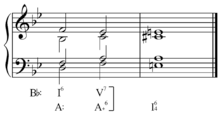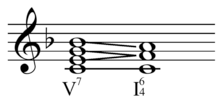Irregular resolution


In music, an irregular resolution is resolution by a dominant seventh chord or diminished seventh chord to a chord other than the tonic. Regarding the dominant seventh, there are many irregular resolutions including to a chord with which it has tones in common or if the parts move only a whole or half step.[2] Consecutive fifths and octaves, augmented intervals, and false relations should still be avoided.[2] Voice leading may cause the seventh to ascend, to be prolonged into the next chord, or to be unresolved.[3]
The following resolutions to a chord with tones in common have been identified:
- Type I, in which the root motion descends by minor third. C, E, G, B♭ would resolve to C♯, E, G, A; two tones are common, two voices move by half-step in contrary motion.
- Type II, in which the root motion rises by minor third. C, E, G, B♭ would resolve to D♭, E♭, G, B♭; again, two tones are common, two voices move by half-step in contrary motion.
- Type III, in which the root moves a tritone (two minor thirds) away. C, E, G, B♭ would resolve to C♯, E, F♯, B♭ = A♯; again, two tones are common (with enharmonic change), two voices move by half-step in contrary motion.

Type I is common from the 18th century; Type II may be found from the second quarter of the 19th century; Type III may be found from the mid-19th century. The composer Richard Edward Wilson is responsible for the categorization.
The most important irregular resolution is the deceptive cadence,[3] most commonly V7-vi in major or V7-VI in minor.[1][3] Irregular resolutions also include V7 becoming A6 [specifically a German sixth] through enharmonic equivalence[1] or in other words (and the image to the right) resolving to the I chord in the key the augmented sixth chord (FACD♯) would be in (A) rather than the key the dominant seventh (FACE♭) would be in (B♭).
See also
Sources
| ||||||||||||||||||||||||||||